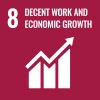
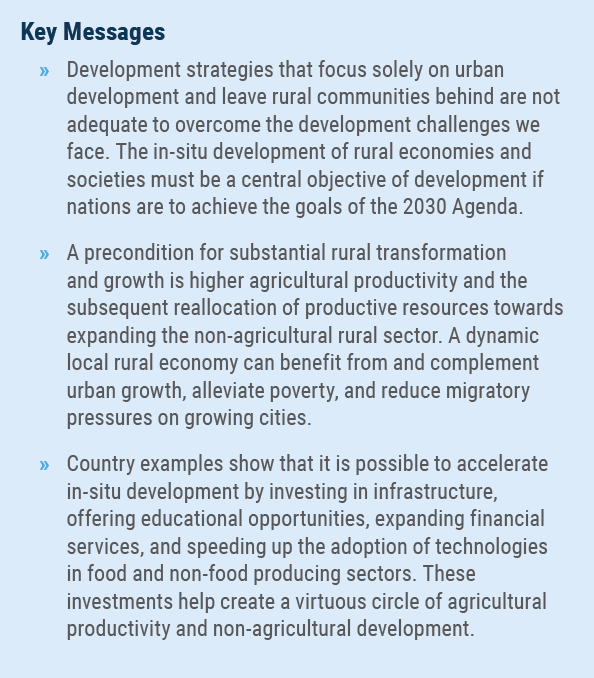 This Brief argues that historical and empirical evidence justifies thinking of rural development not as an appendage of urban progress, but as a driver and integral part of national development. Moreover, the development of farm and non-farm rural economies offers the best chance to accelerate income growth and poverty reduction in rural areas while unlocking resources to help advance the economy as a whole. It follows that developing rural areas in-situ, rather than ignoring them in favor of urban development, should be a central objective of government policy. In practice, this means raising the productivity of agriculture through necessary investments in more and better inputs – including labor – and reducing the costs of transportation, finance, technology, and other services. It also means promoting spillovers into non-farm and non-agricultural sectors, especially in rural communities. Making rural communities vibrant centers of entrepreneurship and innovation has been shown to rapidly increase incomes and development. This Brief concludes with a selection of policy priorities that have been used successfully in some countries and are adaptable to other national contexts.
This Brief argues that historical and empirical evidence justifies thinking of rural development not as an appendage of urban progress, but as a driver and integral part of national development. Moreover, the development of farm and non-farm rural economies offers the best chance to accelerate income growth and poverty reduction in rural areas while unlocking resources to help advance the economy as a whole. It follows that developing rural areas in-situ, rather than ignoring them in favor of urban development, should be a central objective of government policy. In practice, this means raising the productivity of agriculture through necessary investments in more and better inputs – including labor – and reducing the costs of transportation, finance, technology, and other services. It also means promoting spillovers into non-farm and non-agricultural sectors, especially in rural communities. Making rural communities vibrant centers of entrepreneurship and innovation has been shown to rapidly increase incomes and development. This Brief concludes with a selection of policy priorities that have been used successfully in some countries and are adaptable to other national contexts.
Rural development is not synonymous with urbanization
Theories of rural development have been proposed and studied for many years. In most theories, however, rural areas are treated as a problem rather than as a solution to growth and sustainable development. Development is defined as a move away from rural activities as people migrate to cities in search of higher-paying jobs. Rural areas becoming synonymous with poverty and urban areas with progress. The association of rural areas with lower incomes emerges from models of development where rural productivity gains result in migration to urban industrial and service sector jobs. The scale and speed of urban growth more than justify the focus on urban growth even though rural income growth has a more direct impact on poverty reduction. In short, the classical, pro-urban perspective sees cities as engines of growth and poverty reduction and argues against having a “rural bias” in development that over-emphasizes agriculture and rural development (Collier and Dercon, 2014). 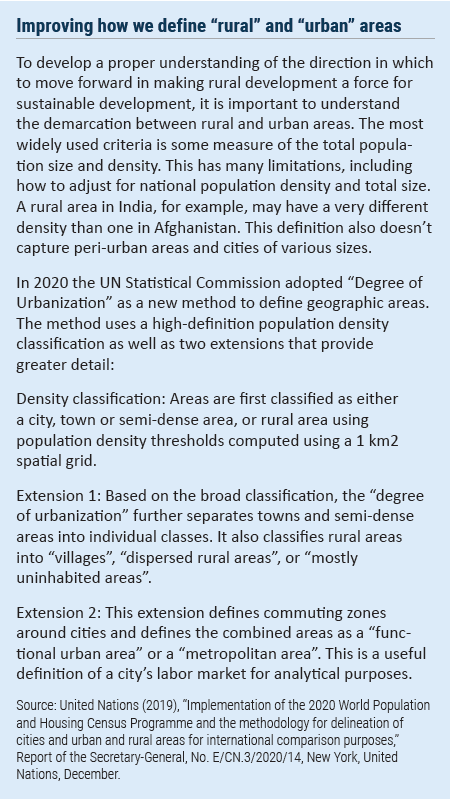 A competing perspective places the development of agriculture and rural communities as the primary driver of poverty reduction and development. This rural-first thinking relies on the intersection of two facts. First, rural communities are underperforming compared to urban areas and thus present untapped potential that can be accelerated (Thurlow, Resnick and Ubogu, 2015). Second, poverty is more intense in rural areas and therefore faster rural growth is a potent poverty-reducing mechanism. In short, the rural-first perspective sees agriculture and rural development as still having a central role in promoting development in all but the most advanced economies and argues for continued investments that support agriculture and non-farm activities in rural communities (Otsuka and Fan, 2020). More recent approaches merge these two perspectives in a more nuanced view of development, one that places equal importance on urban and rural communities. This combined perspective argues for the in-situ development of rural communities based on higher agricultural productivity, a more dynamic non-farm rural economy, and deeper linkages with urban communities. Additionally, the in-situ development model does not result in either emigration or the creation of new urban centers but rather sees a rise in the standard of living of the rural population to approach the one experienced in the urban parts of the country. This model argues for the achievement of a more geographically balanced settlement of people within a nation that reduces migration pressures and improves the sustainability of the urbanization process (Asada, 2020).
A competing perspective places the development of agriculture and rural communities as the primary driver of poverty reduction and development. This rural-first thinking relies on the intersection of two facts. First, rural communities are underperforming compared to urban areas and thus present untapped potential that can be accelerated (Thurlow, Resnick and Ubogu, 2015). Second, poverty is more intense in rural areas and therefore faster rural growth is a potent poverty-reducing mechanism. In short, the rural-first perspective sees agriculture and rural development as still having a central role in promoting development in all but the most advanced economies and argues for continued investments that support agriculture and non-farm activities in rural communities (Otsuka and Fan, 2020). More recent approaches merge these two perspectives in a more nuanced view of development, one that places equal importance on urban and rural communities. This combined perspective argues for the in-situ development of rural communities based on higher agricultural productivity, a more dynamic non-farm rural economy, and deeper linkages with urban communities. Additionally, the in-situ development model does not result in either emigration or the creation of new urban centers but rather sees a rise in the standard of living of the rural population to approach the one experienced in the urban parts of the country. This model argues for the achievement of a more geographically balanced settlement of people within a nation that reduces migration pressures and improves the sustainability of the urbanization process (Asada, 2020).
Importance of agricultural productivity for growth and development
Agriculture accounts for a significant fraction of the economic activity in developing countries and is one of the defining characteristics of rural communities (IFAD, 2016; UN DESA, 2021). The size of the agricultural sector in developing countries implies that agricultural productivity growth should have significant effects on economic growth. The correlations between productivity and GDP per capita growth are positive in all regions of the world and are more pronounced in lower-income areas (Figure 1). There are also strong theoretical and empirical underpinnings that connect agricultural productivity with growth and development. Since poverty is more predominant in rural populations and since many of the poor depend directly or indirectly on the farm sector for their incomes, agricultural productivity gains that lead to growth and higher incomes of small-scale farmers and landless laborers are particularly important in reducing poverty and improving food security.  The evidence further shows that the poverty impact of higher productivity in agriculture is more pronounced than if the productivity gains happen in non-agricultural sectors (Figure 2). The poverty-reducing effect of agricultural sector productivity growth is more pronounced in the poorest populations within countries (Christiaensen and Martin, 2018; Ivanic and Martin, 2018). But this effect is not universal and is sensitive to differences in agricultural settings such as climate and soils, as well as policies, institutions, access to markets, and other factors.
The evidence further shows that the poverty impact of higher productivity in agriculture is more pronounced than if the productivity gains happen in non-agricultural sectors (Figure 2). The poverty-reducing effect of agricultural sector productivity growth is more pronounced in the poorest populations within countries (Christiaensen and Martin, 2018; Ivanic and Martin, 2018). But this effect is not universal and is sensitive to differences in agricultural settings such as climate and soils, as well as policies, institutions, access to markets, and other factors.
The combined benefits of agricultural productivity and positive spill-overs
Agricultural productivity gains can come from the use of technology and the modernization of value-chains, and these can be phased, depending on national context: a) basic productivity investments to spur broad-based productivity growth in primary agriculture; b) modernization of agriculture to sustain, widen and diversify productivity and income growth; and c) sustaining the agrifood system to provide groups with agriculture-based livelihoods and opportunities. All these improvements also lead to additional dynamic benefits of agricultural productivity growth as achieving higher labor productivity helps to release household labor from agricultural activities and the reallocation of labor from agricultural to non-agricultural sectors, which are often more skill-intensive. Encouraging mutually supporting linkages between agricultural and non-agricultural sectors requires the promotion of upstream and downstream providers in agrifood and non-food value chains. This lowers input costs and facilitates the processing and marketing of products, benefiting the growth of rural businesses. Over the long run, investments in the food value chain beyond agriculture generate additional private investments in businesses and support a more productive and thriving rural population. 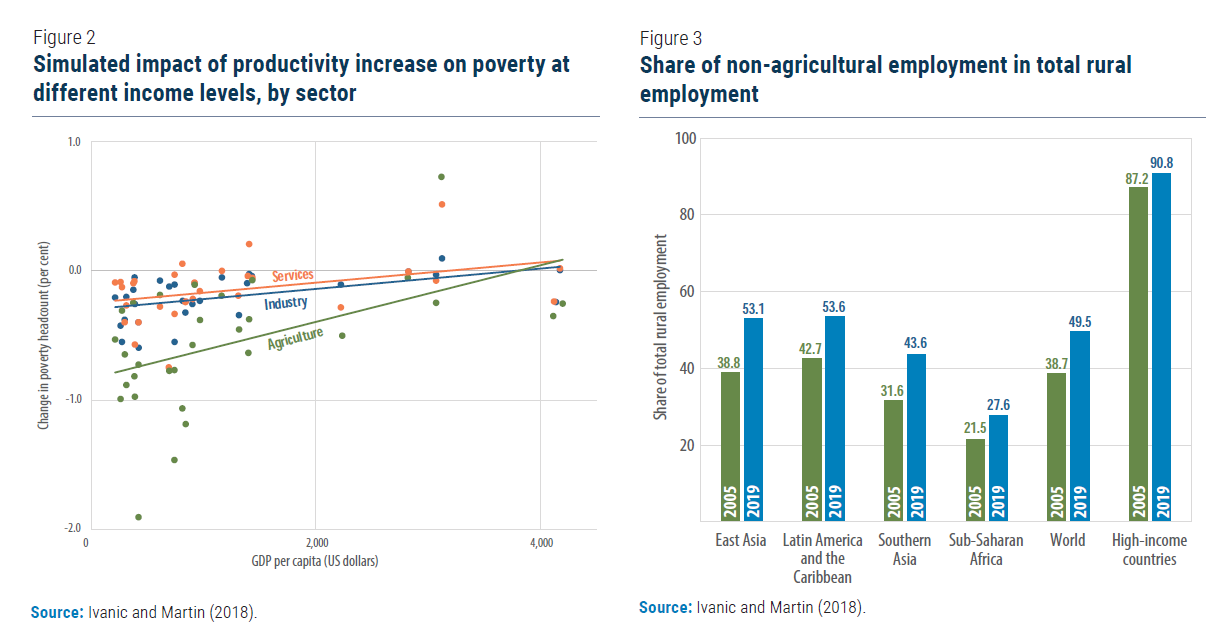 This process has been occurring in every region of the world in various degrees. Data between 2005 and 2016 shows how global employment in non-agricultural activities in rural communities has increased as a share of total rural employment by nearly 11 percentage points and now accounts for half of total rural jobs. While the differences across regions and country incomes are large, the trend is consistent (Figure 3). In 2016, an estimated 35 to 50 per cent of rural incomes in developing countries came from productive activities in the rural, non-farm economy (World Bank, 2016). For many developing economies, neither agricultural nor rural transformation is occurring at the pace or to the extent that is compatible with sustained growth and generation of decent work in rural areas. Global agricultural productivity growth has been below the rate needed to sustain the projected need for food, feed, fiber, and biofuel in the coming decades (Steensland, 2020). Case studies in Africa suggest that the non-farm sector remains small relative to other regions (Figure 3) and that growth is constrained by physical and institutional factors (IFAD, 2016). The combined power of agricultural and non-agricultural development is a powerful tool for poverty reduction. Where investments are made in a more dynamic and diversified rural economy, particularly in the growth of non-farm activities, countries have seen significant socio-economic development and reduction in poverty. Evidence shows that non-agricultural growth in some sectors, such as transport services and manufacturing (especially agro-processing), is as effective for reducing poverty as growth in agriculture (Dorosh and Thurlow, 2018). The gains are especially important to the very poor and landless populations in rural areas, and to women or older persons who are less likely to migrate to larger cities. For women, this can be transformative. In most developing countries, rural women take on a variety of farm production and output processing operations as part of their extended household work. Many women also work in non-farm activities as hired labour and can benefit from additional employment opportunities made available in rural communities (UN DESA, 2021). A study of more than 3,300 individuals from rural households in the United Republic of Tanzania found that about half of those who escaped poverty benefited from the rural non-farm economy or economic opportunities in smaller towns, rather than urban centers (Christiaensen, Weerdt and Todo, 2013). This effect was significantly larger than the poverty-reducing effect of moving to big cities. Indonesia recognized the importance of local non-farm activities for development and poverty reduction in the 1980s. Farm and non-farm activities co-exist within the predominantly rural landscape of the areas adjacent to large cities – termed “desakota”. Conversely, in cases where there was a lack of investment in non-farm activities, the benefits to development and poverty reduction have been small. Improvement in agricultural productivity alone would not lead to broad-based and immediate poverty reduction, since the benefits would be mostly captured by farmers who live above the poverty line. Rural development is also a powerful tool for greater inclusivity in the benefits of development if it includes improved land rights and participation of women, minority groups, and indigenous peoples. Greater access to other productive assets and extension services also boosts off-farm economic activities of women and girls and leads to additional sources of family income (UN DESA, 2021).
This process has been occurring in every region of the world in various degrees. Data between 2005 and 2016 shows how global employment in non-agricultural activities in rural communities has increased as a share of total rural employment by nearly 11 percentage points and now accounts for half of total rural jobs. While the differences across regions and country incomes are large, the trend is consistent (Figure 3). In 2016, an estimated 35 to 50 per cent of rural incomes in developing countries came from productive activities in the rural, non-farm economy (World Bank, 2016). For many developing economies, neither agricultural nor rural transformation is occurring at the pace or to the extent that is compatible with sustained growth and generation of decent work in rural areas. Global agricultural productivity growth has been below the rate needed to sustain the projected need for food, feed, fiber, and biofuel in the coming decades (Steensland, 2020). Case studies in Africa suggest that the non-farm sector remains small relative to other regions (Figure 3) and that growth is constrained by physical and institutional factors (IFAD, 2016). The combined power of agricultural and non-agricultural development is a powerful tool for poverty reduction. Where investments are made in a more dynamic and diversified rural economy, particularly in the growth of non-farm activities, countries have seen significant socio-economic development and reduction in poverty. Evidence shows that non-agricultural growth in some sectors, such as transport services and manufacturing (especially agro-processing), is as effective for reducing poverty as growth in agriculture (Dorosh and Thurlow, 2018). The gains are especially important to the very poor and landless populations in rural areas, and to women or older persons who are less likely to migrate to larger cities. For women, this can be transformative. In most developing countries, rural women take on a variety of farm production and output processing operations as part of their extended household work. Many women also work in non-farm activities as hired labour and can benefit from additional employment opportunities made available in rural communities (UN DESA, 2021). A study of more than 3,300 individuals from rural households in the United Republic of Tanzania found that about half of those who escaped poverty benefited from the rural non-farm economy or economic opportunities in smaller towns, rather than urban centers (Christiaensen, Weerdt and Todo, 2013). This effect was significantly larger than the poverty-reducing effect of moving to big cities. Indonesia recognized the importance of local non-farm activities for development and poverty reduction in the 1980s. Farm and non-farm activities co-exist within the predominantly rural landscape of the areas adjacent to large cities – termed “desakota”. Conversely, in cases where there was a lack of investment in non-farm activities, the benefits to development and poverty reduction have been small. Improvement in agricultural productivity alone would not lead to broad-based and immediate poverty reduction, since the benefits would be mostly captured by farmers who live above the poverty line. Rural development is also a powerful tool for greater inclusivity in the benefits of development if it includes improved land rights and participation of women, minority groups, and indigenous peoples. Greater access to other productive assets and extension services also boosts off-farm economic activities of women and girls and leads to additional sources of family income (UN DESA, 2021).
Enablers of agricultural and rural transformation
The evidence of the importance of agriculture for economic growth and poverty reduction implies that two changes must happen for rural areas to see significant economic gains and development. The first is a process of agricultural transformation that sees an improvement in agricultural productivity and profitability through commercialization and modernization. Such a transformation represents a shift from mainly subsistence farming to commercial and diversified production (Figure 4). Subsistence and small farmers produce mainly food crops to meet the needs of their families and have little or no surplus (Khalil, and others, 2017). Subsistence farmers sell only what exceeds their needs, incurring the costs of processing, transporting, and marketing their products. More commercial agriculture uses the services of traders, middle-market agents that aggregate products from various farmers and sell them in local markets, benefiting from economies of scale and absorbing the risk of marketing the products. As the agricultural sector transforms farmers increase their productivity to take advantage of more market opportunities for profit. 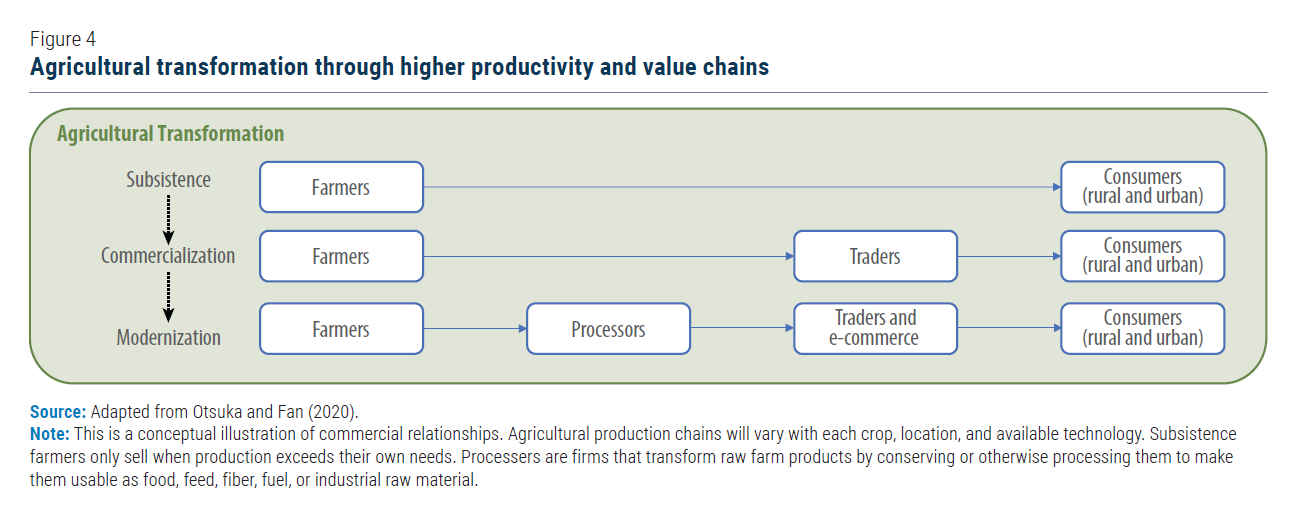 Agricultural transformation isn’t enough, however. It is also important that rural economies also grow beyond farming and agriculture. Gains from higher agricultural productivity and income should spill over into new livelihoods and income-generating opportunities in the rural non-farm sector. More and better-quality inputs, technological innovations, investments in rural research and infrastructure, and better health conditions increase the efficiency and profitability of farming and raise farm incomes. Non-farm sectors also benefit indirectly through better infrastructure, among other benefits. Rural households can also invest in human capital and healthcare to improve productivity and incomes from farm and non-farm activities. The higher incomes and demand also support both farm and non-farm sectors (Figure 5).
Agricultural transformation isn’t enough, however. It is also important that rural economies also grow beyond farming and agriculture. Gains from higher agricultural productivity and income should spill over into new livelihoods and income-generating opportunities in the rural non-farm sector. More and better-quality inputs, technological innovations, investments in rural research and infrastructure, and better health conditions increase the efficiency and profitability of farming and raise farm incomes. Non-farm sectors also benefit indirectly through better infrastructure, among other benefits. Rural households can also invest in human capital and healthcare to improve productivity and incomes from farm and non-farm activities. The higher incomes and demand also support both farm and non-farm sectors (Figure 5).
Proven strategies for strengthening rural economies in-situ
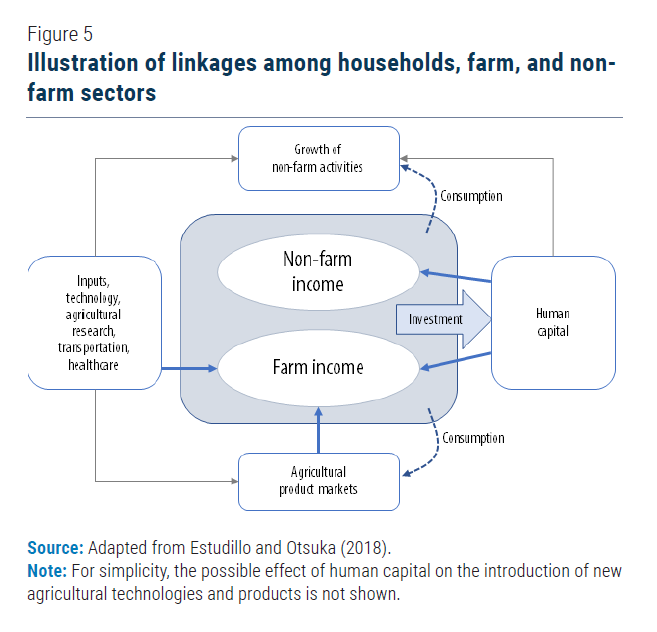 The potential benefits of accelerating agricultural and rural transformation call for a decisive change in the direction of national development planning, placing more emphasis on rural areas and the nexus with cities. As argued above, the development of rural communities requires agricultural productivity growth and the expansion of rural non-farm activities that generate employment and new opportunities.
The potential benefits of accelerating agricultural and rural transformation call for a decisive change in the direction of national development planning, placing more emphasis on rural areas and the nexus with cities. As argued above, the development of rural communities requires agricultural productivity growth and the expansion of rural non-farm activities that generate employment and new opportunities.
Adopting technologies for rural development and connectivity with markets
Past innovations in farming methods, irrigation, fertilizers, seeds, machinery, and countless other examples unlock new levels of agricultural productivity. In addition to expanding access and use of these technologies, new types of technologies, rooted in digital systems and connectivity, can now be used to further boost agricultural productivity and incomes for small and large farmers alike. Farmers can sell their products to an increasingly urban consumer using e-commerce platforms. Agricultural production, processing, and distribution can be made more efficient. Farmers now have access to low-cost mobile payment solutions, crowdfunding platforms, and extension services that use remote sensors and drones, among others. Technology can also make available information about regional and global markets to help rural producers learn of new market opportunities, reach new consumers, and invest in the capabilities required to compete in global value chains. Beyond agriculture, new business ventures and start-ups based on digital and e-commerce technologies make it possible for goods and services to be sourced and provided directly in rural communities, without the need for costly long-distance transportation. Greater connectivity can facilitate in-situ urbanization by making remote work more accessible and by helping many to find training and non-farm employment opportunities.
Expanding infrastructure, health, and education services
The evidence above shows the importance of strengthening and expanding the socioeconomic infrastructure in rural areas by building roads and telecommunications infrastructure, by building more and better schools and hospitals, and by expanding water, sanitation, and electricity networks, among other investments. A recent analysis of the experience in China, Japan, and Sri Lanka provides examples of the benefits of establishing socioeconomic infrastructure and non-farm economic activities in rural areas (Kawamura, 2021). The three countries took very different paths. In China, local and central governments led efforts for in-situ urbanization of rural areas with high population density. The Japanese Government has consistently encouraged development through land reform and other policies, though the rapid structural transformation of the Japanese economy led to much faster development of rural areas than policy alone could achieve. In Sri Lanka, the government used a rural first principle to support rural growth and achieve a more geographically balanced development. In all three, the development of rural areas happened in the context of universal healthcare, universal education, and improved infrastructure.
Unlocking financing for private and public projects in rural areas
Investments in services and infrastructure are expensive and require affordable financing. Developing the right financing and public-private-partnership structures can accelerate investment in basic services to those most in need. For quicker results, governments can support a robust financial network to fund investments. Financing is also needed for private ventures in rural communities. Unfortunately, around the world, the rural population has far less access to finance than their urban counterparts. As of 2017, the share of rural adults with their own financial account (either at a financial institution or through a mobile money provider) was on par with the overall national level in only 15 per cent of countries (Demirgüç-Kunt, and others, 2018). Even in cases where access to finance is available, rural residents typically face higher interest rates, and challenges in receiving credit ratings, all of which disincentivize them from borrowing. Expanding access to rural finance expands options for households and firms to access electricity, adopt more advanced technologies, and invest in education and capacity-building, thereby improving productivity in both rural farm and non-farm sectors. Financial intermediation also allows better cash flow and risk management that are important for effective operation in agricultural and non-agricultural businesses.
Act boldly, but remain vigilant against unintended consequences
It is important to note that the policy strategies discussed here are not without their challenges and could have unintended side effects. The rise of more technologically advanced food value chains and larger commercial farms could concentrate the available financing, land, and labor in a way that undercuts the viability of smaller agricultural businesses, with significant negative social impacts on smaller-scale farmers. Large commercial farms may also have a larger environmental impact due to the greater use of resources, potential use of toxic pesticides, and in instances where farmlands are expanded, may also have significant negative impacts on biodiversity, as is frequently the case with palm oil plantations, for example. It will be important to manage market and incentive structures to ensure adequate innovation and competition that is also compatible with poverty reduction and rural development, while also ensuring inclusive social development and environmental sustainability in line with the 2030 Agenda for Sustainable Development.
 Welcome to the United Nations
Welcome to the United Nations
